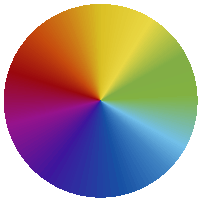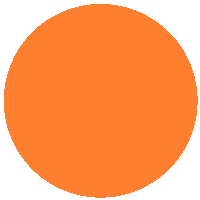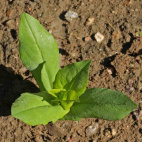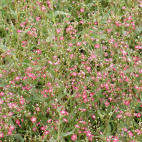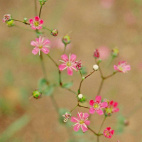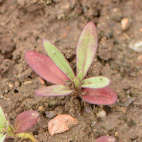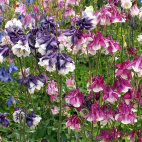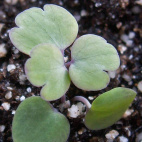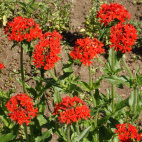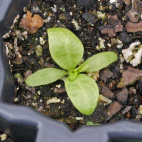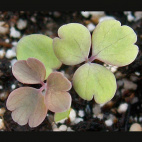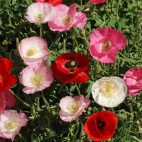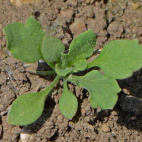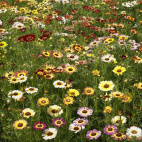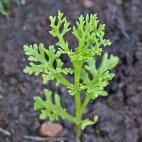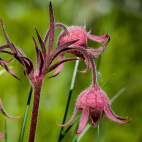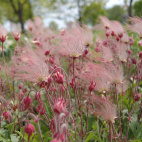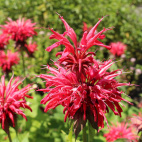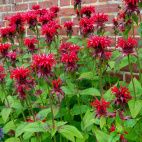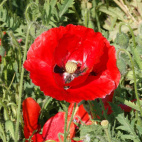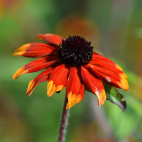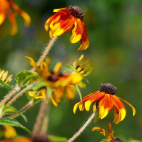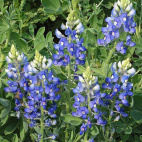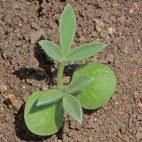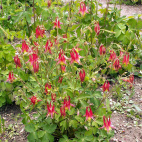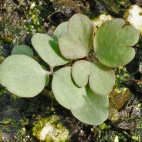Color
Availability
USDA Zone
Region
Type
Duration
Season
Germination
Soil
Sunlight
Height
Use
Narrow Your Search
Color
Availability
USDA Zone
Region
Type
Duration
Season
Germination
Soil
Sunlight
Height
Use
Wildflower Seeds - Northern Region
The Northern region is home to our Canadian friends in the eastern provinces, as well as the northern-most part of the Eastern US. This area is characterized by a long, cold winter with lots of snow, and a short humid summer that only lasts about 3 or 4 months. Most of the area is classified as a UDSA Growing Zone 4 or less, and the species that grow here have interesting ways to perpetuate themselves in spite of the short growing season. There are a lot of forests and wetlands in this region, so adequate moisture is hardly ever a problem. Look up your growing zone to make sure that the Northern wildflower seeds that you want to grow are winter hardy. Alternatively, just order annual flower seeds online so that the plant does not need to make it through the winter, but can reseed itself and come back from seed the next year.
-
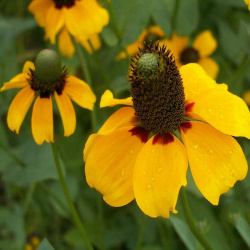 Clasping Coneflower Seeds
Rudbeckia amplexicaulis
Though similar to the Black-Eyed Susan, this bright wildflower is identified by its clasping coneflower leaves and a bit of red showing at the base of the yellow petals. This easy-to-grow annual requires little care and will grow in a wide variety of garden locations.Quick Viewx
Clasping Coneflower Seeds
Rudbeckia amplexicaulis
Though similar to the Black-Eyed Susan, this bright wildflower is identified by its clasping coneflower leaves and a bit of red showing at the base of the yellow petals. This easy-to-grow annual requires little care and will grow in a wide variety of garden locations.Quick ViewxClasping Coneflower Seeds
Rudbeckia amplexicaulis
Though similar to the Black-Eyed Susan, this bright wildflower is identified by its clasping coneflower leaves and a bit of red showing at the base of the yellow petals. This easy-to-grow annual requires little care and will grow in a wide variety of garden locations.
$2.98 Pkt - $7.27 / Oz -
 Deep Carmine Baby's Breath Seeds
Gypsophila elegans
Tiny crimson flowers, and feathery gray-green foliage gives a delicate, airy feel. This annual is perfect for floral arrangements and is very easy to grow in the home garden.Quick View$3.25 Pkt - $9.54 / Oz
Deep Carmine Baby's Breath Seeds
Gypsophila elegans
Tiny crimson flowers, and feathery gray-green foliage gives a delicate, airy feel. This annual is perfect for floral arrangements and is very easy to grow in the home garden.Quick View$3.25 Pkt - $9.54 / Oz -
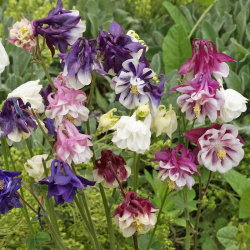 Dwarf Columbine Seed Mix
Aquilegia vulgaris
These delicate, nodding blossoms grow wild throughout much of northern Europe. This 16" dwarf variety produces a lovely mix of colors that will brighten any space!Quick View$3.48 Pkt - $12.65 / Oz
Dwarf Columbine Seed Mix
Aquilegia vulgaris
These delicate, nodding blossoms grow wild throughout much of northern Europe. This 16" dwarf variety produces a lovely mix of colors that will brighten any space!Quick View$3.48 Pkt - $12.65 / Oz -
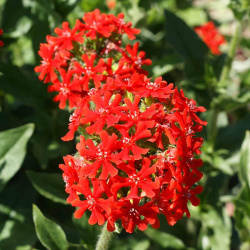 Maltese Cross Seeds
Lychnis chalcedonica
Growing in bright reddish-orange clusters, these striking flowers resemble a pointed star or cross. Hummingbirds and Swallowtail butterflies are attracted to the perennial blooms, which can easily be grown in most flower gardens.Quick View$2.98 Pkt - $9.88 / Oz
Maltese Cross Seeds
Lychnis chalcedonica
Growing in bright reddish-orange clusters, these striking flowers resemble a pointed star or cross. Hummingbirds and Swallowtail butterflies are attracted to the perennial blooms, which can easily be grown in most flower gardens.Quick View$2.98 Pkt - $9.88 / Oz -
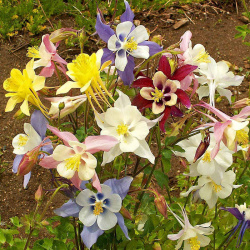 McKana Giants Columbine Seed Mix
Aquilegia caerulea
Developed explicitly for its large colorful blooms, this AAS Award winner first became available in the 1950s. A striking choice for any gardener who loves the distinctive columbine shaped flowers.Quick View$3.48 Pkt - $20.16 / Oz
McKana Giants Columbine Seed Mix
Aquilegia caerulea
Developed explicitly for its large colorful blooms, this AAS Award winner first became available in the 1950s. A striking choice for any gardener who loves the distinctive columbine shaped flowers.Quick View$3.48 Pkt - $20.16 / Oz -
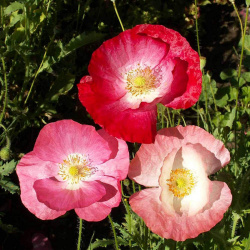 Single Poppy Seed Mix
Papaver rhoeas
Create a shimmering wave of color with this bright mix, which contains the super-popular Red Poppy, along with pink and white variations. This annual often self-sows and is highly attractive to bees, butterflies, and birds.Quick View$2.98 Pkt - $7.59 / Oz
Single Poppy Seed Mix
Papaver rhoeas
Create a shimmering wave of color with this bright mix, which contains the super-popular Red Poppy, along with pink and white variations. This annual often self-sows and is highly attractive to bees, butterflies, and birds.Quick View$2.98 Pkt - $7.59 / Oz -
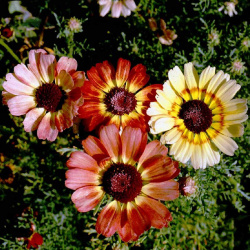 Painted Daisy Seeds
Chrysanthemum carinatum
An annual from the coasts of North Africa, this particular daisy variety boasts a boast a tricolor ring pattern. This showy wildflower blooms through summer and fall and then reseeds itself for the next year's blooms.Quick View$3.48 Pkt - $7.59 / Oz
Painted Daisy Seeds
Chrysanthemum carinatum
An annual from the coasts of North Africa, this particular daisy variety boasts a boast a tricolor ring pattern. This showy wildflower blooms through summer and fall and then reseeds itself for the next year's blooms.Quick View$3.48 Pkt - $7.59 / Oz -
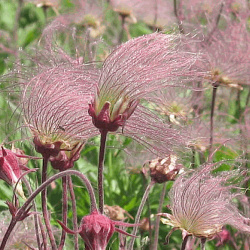 Prairie Smoke Seeds
Geum triflorum
Feathery, pink wisps float atop these dreamy native flowers, like so many plumes of smoke. This small novelty plant will add ornamental value to rock gardens or borders, and interest and diversity to any native planting.Quick View$3.96 Pkt - $280.00 / Oz
Prairie Smoke Seeds
Geum triflorum
Feathery, pink wisps float atop these dreamy native flowers, like so many plumes of smoke. This small novelty plant will add ornamental value to rock gardens or borders, and interest and diversity to any native planting.Quick View$3.96 Pkt - $280.00 / Oz -
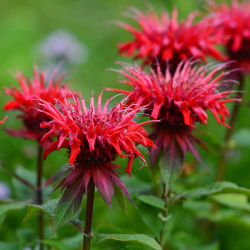 Out Of Stock
Red Bee Balm Seeds
Monarda didyma
Once used as a remedy for bee stings, this wildflower is appreciated as a medicinal herb. The spiky, red blossoms are very attractive to bees, butterflies, and hummingbirds.Quick Viewx
Out Of Stock
Red Bee Balm Seeds
Monarda didyma
Once used as a remedy for bee stings, this wildflower is appreciated as a medicinal herb. The spiky, red blossoms are very attractive to bees, butterflies, and hummingbirds.Quick ViewxRed Bee Balm Seeds
Monarda didyma
Once used as a remedy for bee stings, this wildflower is appreciated as a medicinal herb. The spiky, red blossoms are very attractive to bees, butterflies, and hummingbirds.
$3.96 Pkt - $136.00 / Oz -
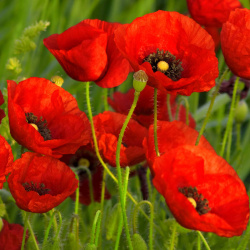 On Sale!
Red Poppy Seeds
Papaver rhoeas
This annual is often used to remember soldiers who were lost in battle. Possibly one of the world's most popular wildflowers, this vivid red beauty does evoke remembrance. Papaver rhoeas seeds are very easy to grow and self-sows readily.Quick View$2.98 Pkt - $7.65 / Oz
On Sale!
Red Poppy Seeds
Papaver rhoeas
This annual is often used to remember soldiers who were lost in battle. Possibly one of the world's most popular wildflowers, this vivid red beauty does evoke remembrance. Papaver rhoeas seeds are very easy to grow and self-sows readily.Quick View$2.98 Pkt - $7.65 / Oz -
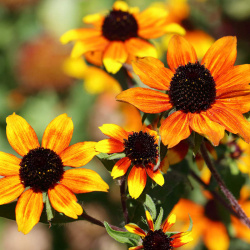 Out Of Stock
Red Sport Seeds
Rudbeckia triloba variation
Red Sport is a naturally occurring variation of Brown-eyed Susan. It produces numerous small blooms that are mostly red but still have a little yellow showing through. It is a short-lived perennial that is quite easy to grow.Quick View$3.48 Pkt - $21.00 / Oz
Out Of Stock
Red Sport Seeds
Rudbeckia triloba variation
Red Sport is a naturally occurring variation of Brown-eyed Susan. It produces numerous small blooms that are mostly red but still have a little yellow showing through. It is a short-lived perennial that is quite easy to grow.Quick View$3.48 Pkt - $21.00 / Oz -
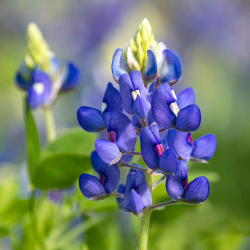 Texas Bluebonnet Seeds
Lupinus texensis
The Bluebonnet is a native wildflower of the deep south and holds the honor of being the State Flower of Texas. The blooms have the unique trait of changing colors as they age, which is why they sometimes look reddish and other times blueish.Quick View$3.48 Pkt - $11.88 / Oz
Texas Bluebonnet Seeds
Lupinus texensis
The Bluebonnet is a native wildflower of the deep south and holds the honor of being the State Flower of Texas. The blooms have the unique trait of changing colors as they age, which is why they sometimes look reddish and other times blueish.Quick View$3.48 Pkt - $11.88 / Oz -
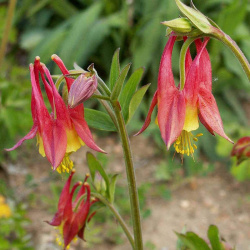 Wild Columbine Seeds
Aquilegia canadensis
Especially attractive to hummingbirds, this wildflower is a perfect choice for nature-lovers. The delicate red and yellow blossoms can grow in the open garden, but they seem to do better with some shelter and shade.Quick View$3.48 Pkt - $26.00 / Oz
Wild Columbine Seeds
Aquilegia canadensis
Especially attractive to hummingbirds, this wildflower is a perfect choice for nature-lovers. The delicate red and yellow blossoms can grow in the open garden, but they seem to do better with some shelter and shade.Quick View$3.48 Pkt - $26.00 / Oz
The Northern region is home to our Canadian friends in the eastern provinces, as well as the northern-most part of the Eastern US. This area is characterized by a long, cold winter with lots of snow, and a short humid summer that only lasts about 3 or 4 months. Most of the area is classified as a UDSA Growing Zone 4 or less, and the species that grow here have interesting ways to perpetuate themselves in spite of the short growing season. There are a lot of forests and wetlands in this region, so adequate moisture is hardly ever a problem. Look up your growing zone to make sure that the Northern wildflower seeds that you want to grow are winter hardy. Alternatively, just order annual flower seeds online so that the plant does not need to make it through the winter, but can reseed itself and come back from seed the next year.


